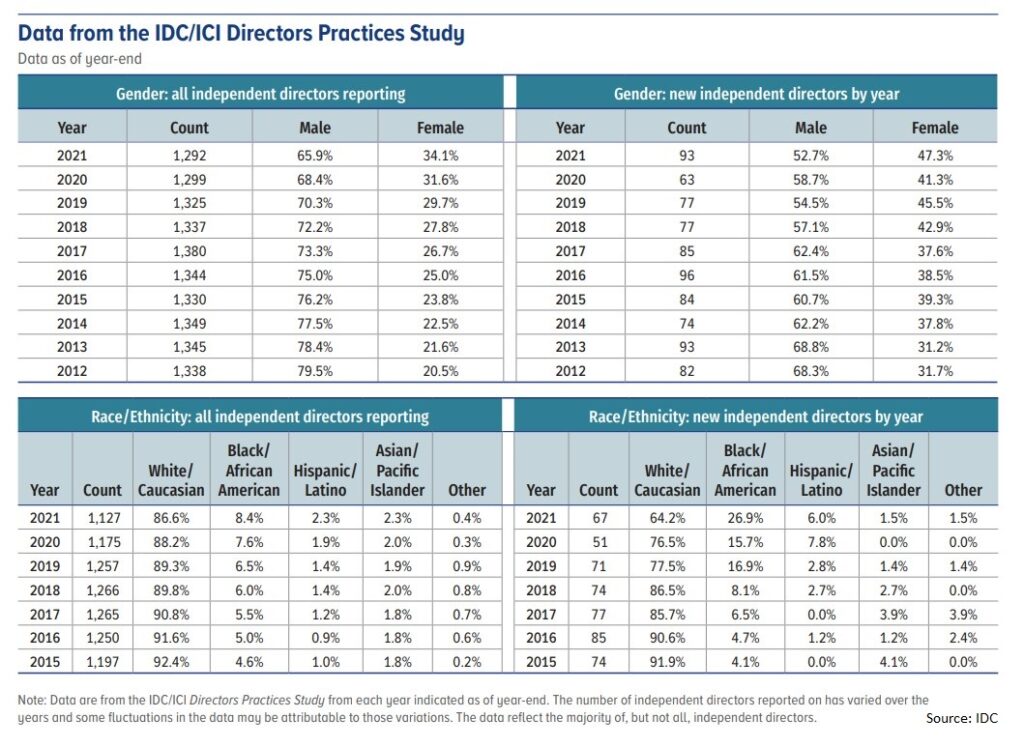Racial- and ethnic-minority representation of the asset-management industry rose between 2020 and 2022, while the percentage of women working in the industry fell, according to a survey announced May 30 by the Investment Company Institute (ICI).
The percentage of racial and ethnic minorities working in asset-management jobs rose from 30.5% in 2020 to 34.4% in 2022 according to the 2022 ICI U.S. Asset Management Diversity & Inclusion Survey. The percentage of women in those jobs dropped from 41.8% during 2020 to 39.7% during 2022, according to the two-page report, which was released in May and was based on surveys conducted during late fall 2022, according to the ICI release.

This is ICI’s second effort to measure the diversity of member companies and the relative success of their diversity and inclusion (D&I) program. Like the first survey effort in 2020, however, the 2022 edition got very little response.
Only 68 companies responded to the first part of the survey, which focused on questions about any D&I goals member companies may have set and the measures they took to achieve those goals, compared to 65 companies that responded to the first survey in 2020.
The second part of the survey – which focused on demographic questions about employees in job categories specific to the asset-management industry rather than more generic federal jobs reports – yielded only 53 responses, from companies representing 80,000 employees with $21.1tn as of June 30 2022, compared to the 2020 survey that netted 56 responses representing 93,000 employees.
“ICI members have expressed a desire to improve the inclusion of more women and people from underserved and underrepresented communities in their organizations. ICI’s D&I survey allows them to benchmark their progress and evaluate the effectiveness of their efforts,” Eric Pan, ICI president and CEO said in the May 30 announcement.
An ICI spokesperson said the association has no explanation to offer about the drop in the percentage of women in the industry, and has no figures available that are more recent than the survey that is listed as having been conducted in the late fall of 2022.
The fund-focused Independent Directors Council (IDC), which also surveys members about diversity and D&I initiatives, probably won’t follow up until late this year on its original report on fund board demographics, published Feb. 23, 2021.
IDC did release tables with data listed as current as of the end of 2021, which was collected but had not been made public outside the organization, the spokesperson said.
Those tables do not cover the portion of 2022 that shows a drop in women’s employment in the ICI report but do show increases in the number of both women and minority members on fund boards through the end of 2021.
Because board memberships tend to be longstanding and turnover tends to be slow, IDC’s D&I numbers attempt to measure the speed of change more accurately by including one table showing the demographic breakdown of all board members and another that breaks down only newly appointed board members.
As of the end of 2021, that data shows that the percentage of newly appointed independent directors who are women rose to 47.3% during 2021 compared to 41.3% in 2020. The percentage of all women independent directors, meanwhile, rose to 34.1% at the end of 2021 from 31.6% at the end of 2020.
The percentage of newly appointed board members who identified their racial/ethnic background as Black/African-American, Hispanic/Latino, Asian/Pacific Islander or Other rose to 35.9% at the end of 2021 compared to 23.5% at the end of 2020. The percentage of all board members identifying as any category other than White/Caucasian rose to 13.4% at the end of 2021 compared to 11.5% at the end of 2020.

